Overview
The article focuses on effective exercises for mastering functional core strength, emphasizing its importance for both athletic performance and everyday activities. It supports this by detailing various exercises like planks, dead bugs, and bird dogs, which enhance stability, balance, and injury prevention, while also referencing research that underscores the benefits of these foundational movements in improving overall physical capability.
Introduction
In a world where physical demands are ever-increasing, the importance of functional core strength cannot be overstated. This foundational element of fitness is not solely reserved for elite athletes; it is vital for everyone seeking to enhance their overall well-being and performance.
With core strength serving as the bedrock for stability, balance, and effective movement, individuals can experience profound benefits across all aspects of life. From reducing injury risks to improving daily functionality, the advantages of prioritizing core training are immense.
By embracing simple yet effective exercises and understanding the science behind core strength, HR Benefits Managers have the opportunity to empower their teams, fostering a culture of health and resilience that translates into both personal and professional success.
Understanding Functional Core Strength: The Foundation of Fitness
Functional core strength encompasses the essential muscles found in your abdomen, lower back, hips, and pelvis, which work together to stabilize your body and enable movement. This power is crucial for everyone, not just athletes, as it significantly enhances balance, stability, and posture across various age groups, as studies evaluating both youth and adults have shown. Investing in the enhancement of functional foundational power can lead to improved performance in sports, a decreased risk of injuries, and a more efficient execution of everyday tasks such as lifting or bending.
Basic workouts such as sit-ups and planks can assist individuals in evaluating their central stability efficiently. As Emma insightfully remarks,
It’s always good to move your body in all planes, and you can really feel the burn.
Functional core strength is the foundation of fitness, enabling effective movement patterns across all activities.
A systematic review emphasizes that incorporating fundamental exercises into athletic programs is crucial, with customized suggestions for frequency and duration based on outcome variables. The case study titled 'Conclusions on Central Exercise for Athletic Achievement' highlights this necessity, offering proof that central exercise is essential for improving athletic achievement. With the latest research revealing that only two out of 418 articles met inclusion criteria, it's clear that the significance of fundamental strength in fitness is gaining recognition.
By prioritizing essential training, HR Benefits Managers can empower their teams to enhance their overall wellness and performance.
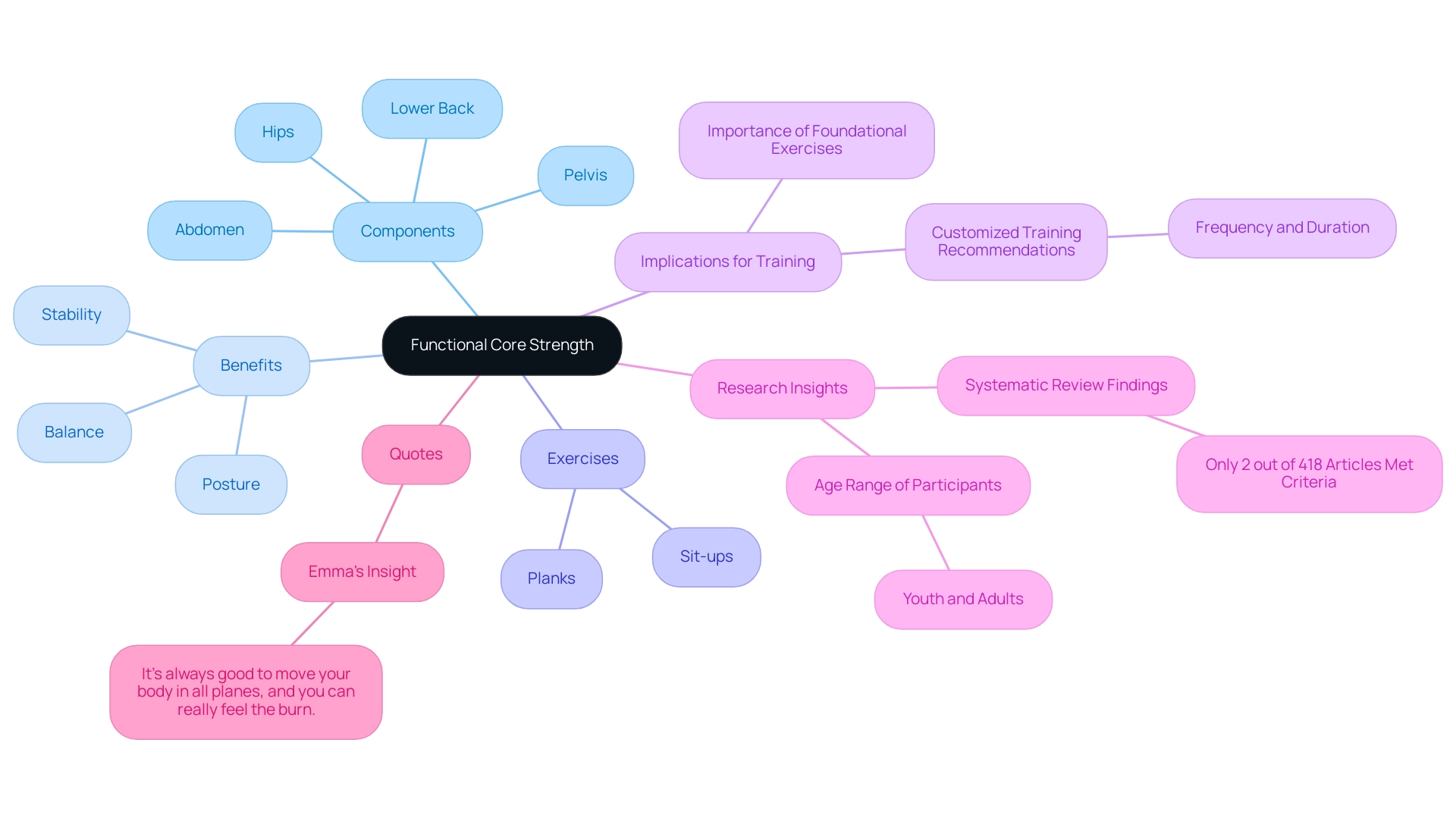
Effective Exercises for Building Functional Core Strength
- Plank: Start in a forearm plank position, maintaining a straight line from head to heels. Concentrate on activating your center and maintain this position for 30 seconds to 1 minute. This foundational exercise not only builds functional core strength but also enhances posture and stability. Research by McGill & Marshall (2012) supports this exercise's effectiveness, showing moderate evidence for its impact on abdominal strength.
- Dead Bug: Lie on your back with your arms extended toward the ceiling and knees bent at 90 degrees. Slowly lower one arm and the opposite leg toward the floor while keeping your back flat, then return to the starting position. This exercise enhances coordination and builds functional core strength in the abdominal muscles. Repeat on the other side. Incorporating such exercises can help address the high heterogeneity found in balance and vertical jump capabilities (≈ 60%) as noted in current studies.
- Bird Dog: Begin on all fours, ensuring your spine is neutral. Extend one arm forward and the opposite leg back, activating your midsection to maintain balance. Hold for a few seconds before returning to the starting position. Alternate sides. This movement helps improve stability and coordination, which are essential for overall athletic performance and contribute to developing functional core strength, as highlighted in the findings of McGill & Marshall (2012).
- Russian Twist: Sit on the floor with your knees bent and feet flat. Lean back slightly while holding a weight or medicine ball. Twist your torso to one side, then the other, activating your muscles throughout the movement. This dynamic exercise targets your obliques and helps improve functional core strength. The effectiveness of rotational exercises like this is further supported by the case study of McGill & Marshall, which emphasizes the importance of varied abdominal exercises.
These exercises are adaptable for all fitness levels, making them ideal for both beginners and advanced practitioners. By integrating them into your routine, you can cultivate a culture of wellness and resilience within your team, paving the way for improved outcomes and well-being.
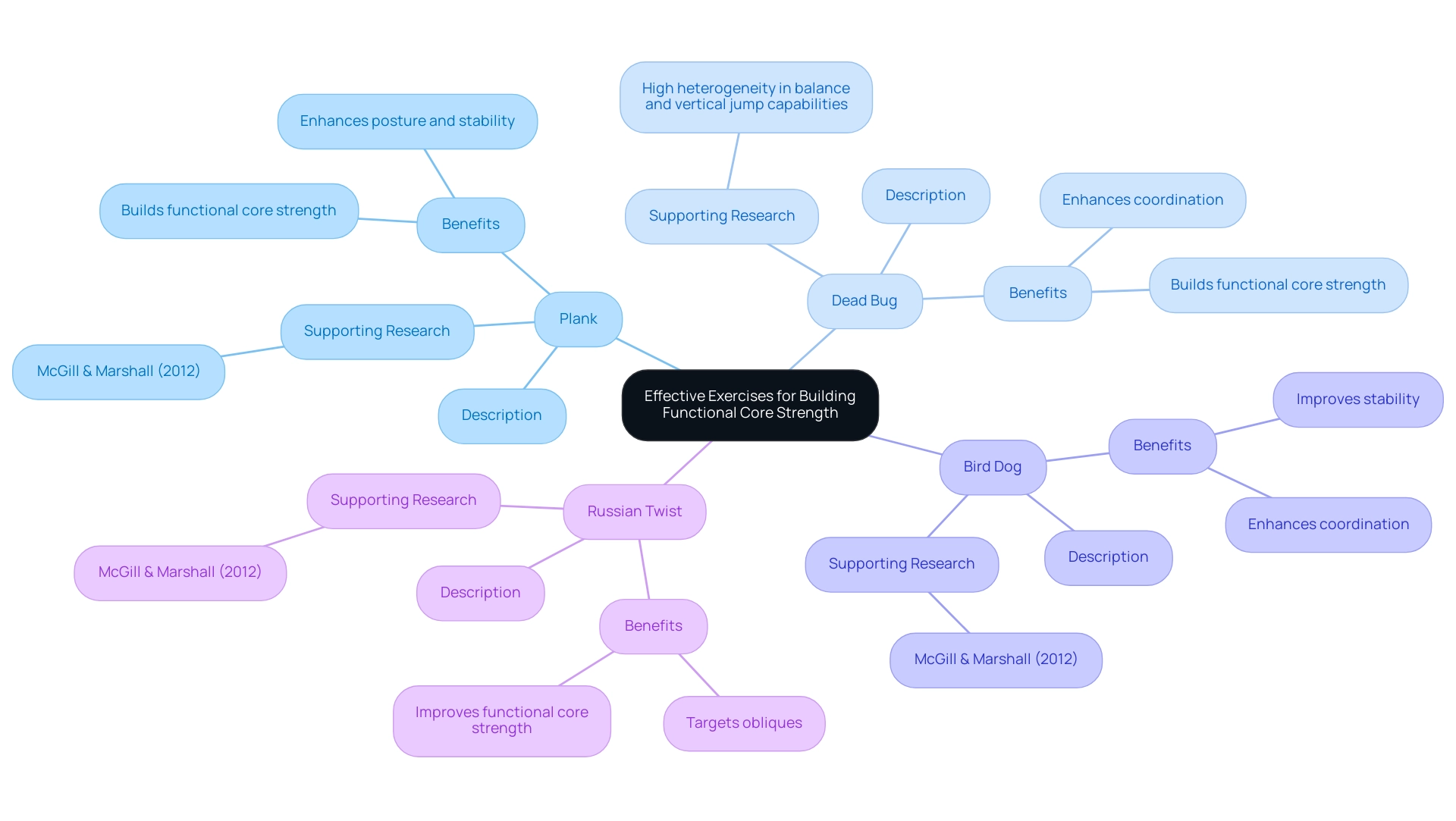
The Benefits of Functional Core Training for Athletes and Everyday Life
Functional foundational exercises offer a variety of compelling benefits that enhance functional core strength, which is essential for athletes and advantageous for daily living.
-
Enhanced Athletic Capability: Functional core strength is essential for producing power and preserving stability during physical activities, which results in improved effectiveness across various sports such as running, swimming, and weightlifting. Recent findings from a study by Park, Hyun and Jee (2016) indicate that athletes participating in central muscle conditioning can achieve significant enhancements in performance metrics, particularly when adhering to a structured regimen over a defined period.
For example, a case study involving 44 male teenage basketball players showed that those who engaged in stability exercises exhibited better outcomes in dynamic balance and agility than their peers in traditional workouts, with significant improvements in dribbling skills over time.
-
Injury Prevention: Strengthening the muscles surrounding the spine and pelvis is crucial for reducing injury risks, especially concerning lower back strain. A well-organized central training program can lead to significant decreases in injury occurrences, as data emphasizes the strong link between functional core strength and injury avoidance.
KS emphasizes that the significance of functional core strength cannot be overstated, as it lays the foundation for both athletic success and everyday resilience, reinforcing the notion that a strong functional core strength is key to mitigating injury risks.
-
Improved Posture and Balance: A well-developed center supports proper posture, thereby reducing discomfort and injuries often associated with poor body mechanics. This element of foundational exercise is crucial for athletes who need optimal alignment and functional core strength during performance.
-
Enhanced Daily Functionality: With a strong foundation, everyday activities become less taxing, contributing to lower fatigue levels and improved physical capability. This enhanced functionality not only benefits athletes but also translates to better overall wellness for individuals in their daily routines.
These multifaceted benefits emphasize the essential role of functional core strength in both athletic endeavors and daily functionality, advocating for its integration into training programs.
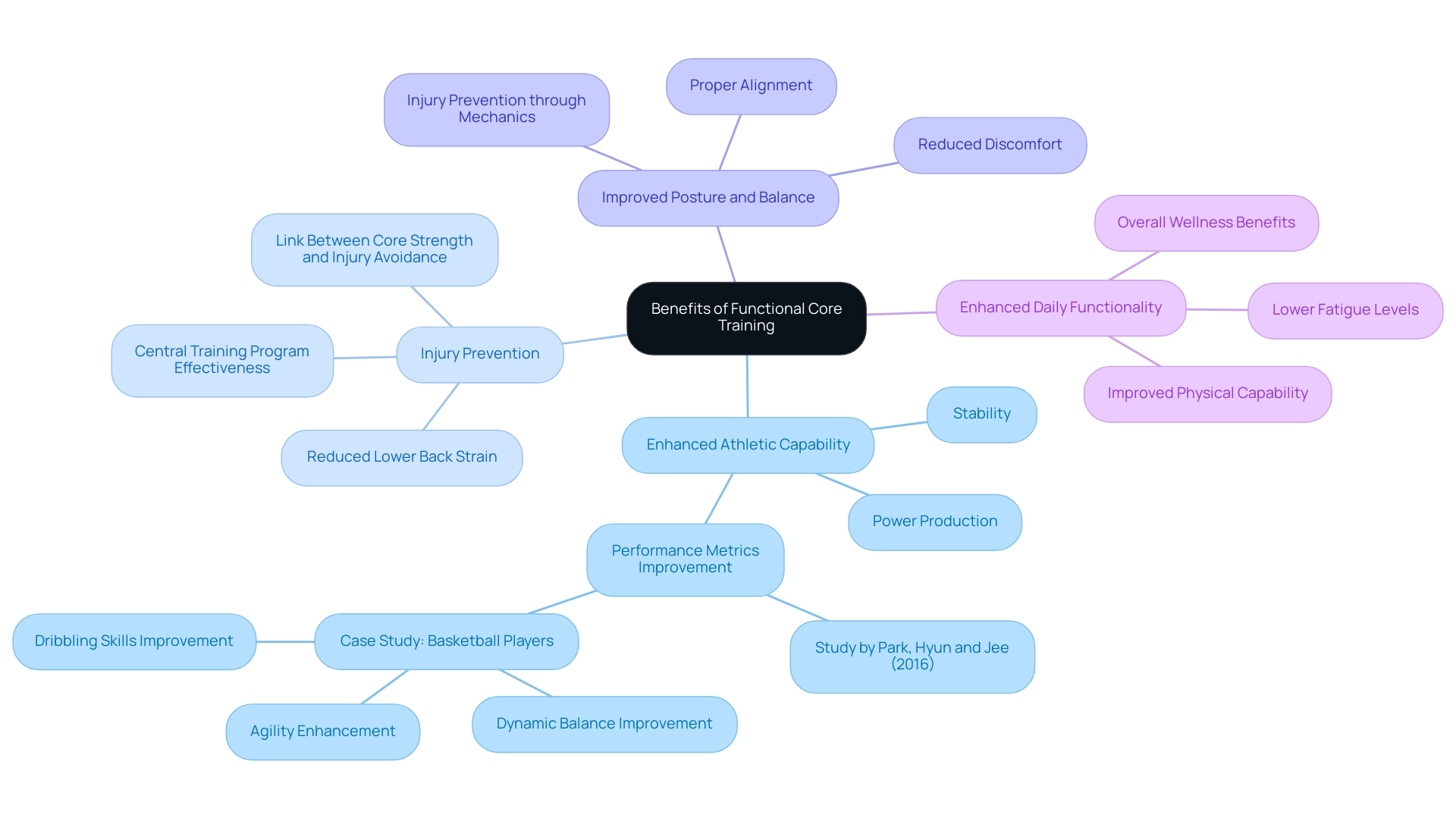
Advanced Techniques for Mastering Core Strength
- Stability Ball Rollout: Begin by kneeling on the floor with a stability ball positioned in front of you. Place your forearms on the ball, and as you roll it forward, maintain a straight body alignment. This exercise not only involves your midsection but also fortifies your shoulders and back. As you pull the ball back to your starting position, focus on engaging your abdominal muscles for optimal effectiveness. Recent studies have indicated that isolated central conditioning (ICT) can significantly affect performance, with a standardized mean difference (SMD) of 0.52.
- Hanging Leg Raises: Find a sturdy pull-up bar and hang from it, allowing your legs to dangle. Engage your center as you raise your legs straight in front of you, targeting your lower abdominal muscles. This exercise requires considerable functional core strength and stability, making it a superb addition to any advanced workout routine. According to a systematic review involving 3223 studies, the effectiveness of central training is well-documented, with combined central training (CCT) showing an even larger SMD of 1.67.
- Side Plank with Leg Lift: Start in a side plank position, supporting your weight on one forearm and the side of your foot. As you stabilize your body, lift your top leg and hold it for a few seconds before lowering it. This variation not only challenges your obliques but also enhances overall stability and balance, which are essential components of functional core strength and athletic performance. A case study titled 'Discussion on Training Effects' synthesized findings from eight randomized controlled trials, highlighting the significant improvements in physical power and central endurance.
- Medicine Ball Slams: Stand with your feet shoulder-width apart, gripping a medicine ball with both hands. Lift the ball above your head and smash it down to the ground with power, activating your muscles throughout the motion. This explosive activity is excellent for developing power while introducing an exciting dynamic to your workouts.
These advanced stability enhancing techniques not only improve physical vigor but also enhance functional core strength, adding variety to your exercise routine and keeping your sessions fresh and inspiring. As highlighted by Daniel Jerez-Mayorga, 'A total of 3223 studies were identified, 22 studies were included in the systematic review and 21 for the meta-analysis,' emphasizing the extensive research supporting the effectiveness of foundational training.
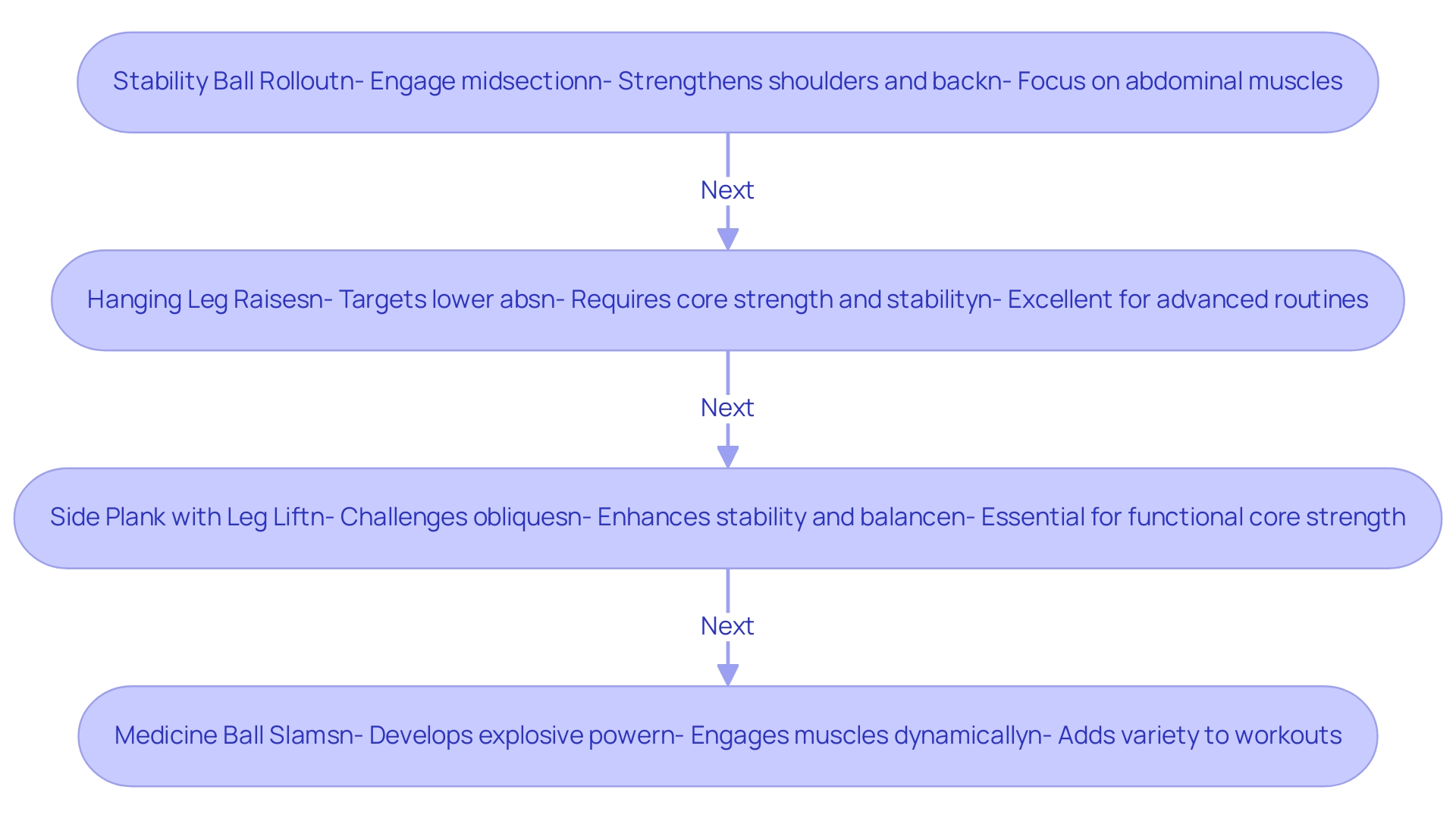
Core Strength and Its Role in Rehabilitation and Injury Prevention
Central stability is essential in rehabilitation and injury avoidance, serving multiple crucial functions:
- Stabilizing the Spine: A strong central area effectively stabilizes the spine, considerably decreasing the risk of injuries during the recovery process from ailments or surgeries.
- Supporting Functional Movements: Rehabilitation programs concentrate on retraining functional movements, and having functional core strength is vital for executing these movements safely and effectively.
- Enhancing Recovery: Incorporating fundamental power exercises into rehabilitation strategies not only speeds up recovery but also encourages better mobility, vigor, and stability. According to a recent meta-analysis, fundamental training has shown a positive effect on balance performance, indicating its comprehensive benefits. Furthermore, notable decreases in lost time injuries to the upper extremities have been observed (p = 0.0141), highlighting the significance of foundational strength in preventing injuries.
- Preventing Future Injuries: A well-conditioned center plays a pivotal role in preventing the recurrence of injuries by promoting functional core strength, ensuring that the body maintains proper alignment and support during various activities. As mentioned by Breakthru Physical Therapy, whether recuperating from an injury or merely aiming to improve your physical health, focusing on functional core strength is an essential part of your wellness journey.
Furthermore, the current literature emphasizes difficulties in fundamental research, indicating that although several programs seek to improve sports performance, many lack a solid scientific foundation. By understanding these integral roles, individuals can truly appreciate the broader implications of core training in their health journey, encouraging a proactive approach to wellness.
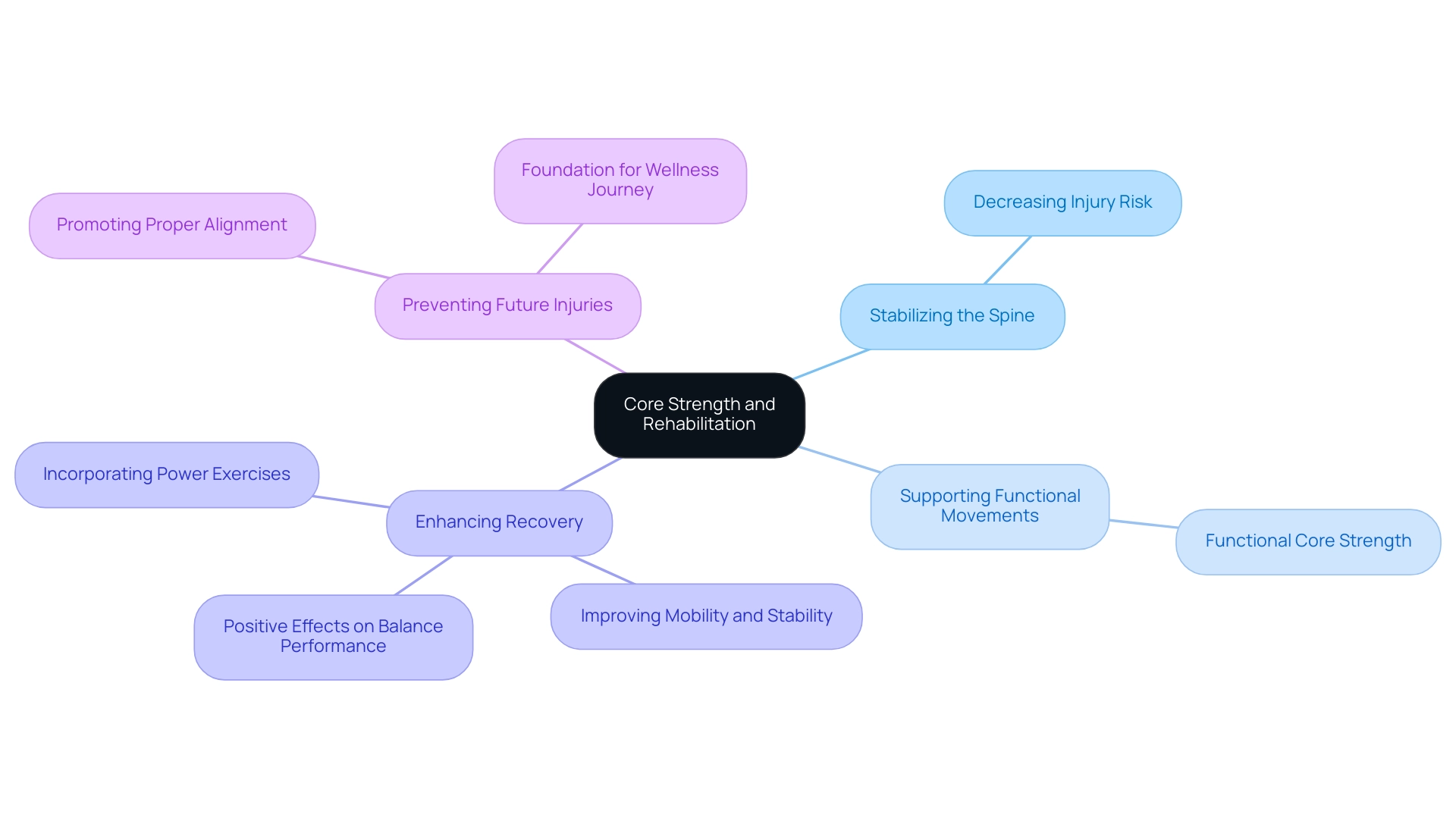
Conclusion
Functional core strength is a cornerstone of overall fitness, offering benefits that extend far beyond athletic performance. By understanding the vital role that core strength plays in enhancing stability, balance, and posture, individuals can appreciate its importance in both sports and everyday activities. The array of exercises detailed—ranging from foundational movements like planks and dead bugs to advanced techniques such as hanging leg raises—provides a comprehensive toolkit for building and maintaining a strong core.
Moreover, the advantages of functional core training are clear. It not only boosts athletic performance but also significantly reduces the risk of injuries and enhances daily functionality. With a strong core, individuals can perform everyday tasks with greater ease and less fatigue, translating into improved quality of life.
For HR Benefits Managers, prioritizing core strength training within wellness programs is an investment in employee health and resilience. By fostering a culture that values physical well-being, organizations can empower their teams to thrive both personally and professionally. Now is the time to take action and integrate core training into workplace wellness initiatives, unlocking the potential for greater performance and overall wellness.




